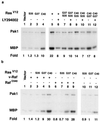Signals from the Ras, Rac, and Rho GTPases converge on the Pak protein kinase in Rat-1 fibroblasts
- PMID: 10022875
- PMCID: PMC83981
- DOI: 10.1128/MCB.19.3.1881
Signals from the Ras, Rac, and Rho GTPases converge on the Pak protein kinase in Rat-1 fibroblasts
Abstract
Ras plays a key role in regulating cellular proliferation, differentiation, and transformation. Raf is the major effector of Ras in the Ras > Raf > Mek > extracellular signal-activated kinase (ERK) cascade. A second effector is phosphoinositide 3-OH kinase (PI 3-kinase), which, in turn, activates the small G protein Rac. Rac also has multiple effectors, one of which is the serine threonine kinase Pak (p65(Pak)). Here we show that Ras, but not Raf, activates Pak1 in cotransfection assays of Rat-1 cells but not NIH 3T3 cells. We tested agents that activate or block specific components downstream of Ras and demonstrate a Ras > PI 3-kinase > Rac/Cdc42 > Pak signal. Although these studies suggest that the signal from Ras through PI 3-kinase is sufficient to activate Pak, additional studies suggested that other effectors contribute to Pak activation. RasV12S35 and RasV12G37, two effector mutant proteins which fail to activate PI 3-kinase, did not activate Pak when tested alone but activated Pak when they were cotransfected. Similarly, RacV12H40, an effector mutant that does not bind Pak, and Rho both cooperated with Raf to activate Pak. A dominant negative Rho mutant also inhibited Ras activation of Pak. All combinations of Rac/Raf and Ras/Raf and Rho/Raf effector mutants that transform cells cooperatively stimulated ERK. Cooperation was Pak dependent, since all combinations were inhibited by kinase-deficient Pak mutants in both transformation assays and ERK activation assays. These data suggest that other Ras effectors can collaborate with PI 3-kinase and with each other to activate Pak. Furthermore, the strong correlation between Pak activation and cooperative transformation suggests that Pak activation is necessary, although not sufficient, for cooperative transformation of Rat-1 fibroblasts by Ras, Rac, and Rho.
Figures











Similar articles
-
Kinase-deficient Pak1 mutants inhibit Ras transformation of Rat-1 fibroblasts.Mol Cell Biol. 1997 Aug;17(8):4454-64. doi: 10.1128/MCB.17.8.4454. Mol Cell Biol. 1997. PMID: 9234703 Free PMC article.
-
Regulation of the protein kinase Raf-1 by oncogenic Ras through phosphatidylinositol 3-kinase, Cdc42/Rac and Pak.Curr Biol. 2000 Mar 9;10(5):281-4. doi: 10.1016/s0960-9822(00)00359-6. Curr Biol. 2000. PMID: 10712905
-
Regulation of phosphorylation pathways by p21 GTPases. The p21 Ras-related Rho subfamily and its role in phosphorylation signalling pathways.Eur J Biochem. 1996 Dec 1;242(2):171-85. doi: 10.1111/j.1432-1033.1996.0171r.x. Eur J Biochem. 1996. PMID: 8973630 Review.
-
Function of the Rho family GTPases in Ras-stimulated Raf activation.J Biol Chem. 2001 Sep 14;276(37):34728-37. doi: 10.1074/jbc.M103496200. Epub 2001 Jul 16. J Biol Chem. 2001. PMID: 11457831
-
Signal-transducing protein phosphorylation cascades mediated by Ras/Rho proteins in the mammalian cell: the potential for multiplex signalling.Biochem J. 1996 Sep 15;318 ( Pt 3)(Pt 3):729-47. doi: 10.1042/bj3180729. Biochem J. 1996. PMID: 8836113 Free PMC article. Review.
Cited by
-
Fluorescent Chiral Quantum Dots to Unveil Origin-Dependent Exosome Uptake and Cargo Release.ACS Appl Bio Mater. 2024 May 20;7(5):3358-3374. doi: 10.1021/acsabm.4c00296. Epub 2024 May 8. ACS Appl Bio Mater. 2024. PMID: 38717870 Free PMC article.
-
Raf-1 serine 338 phosphorylation plays a key role in adhesion-dependent activation of extracellular signal-regulated kinase by epidermal growth factor.Mol Cell Biol. 2005 Jun;25(11):4466-75. doi: 10.1128/MCB.25.11.4466-4475.2005. Mol Cell Biol. 2005. PMID: 15899852 Free PMC article.
-
Active p21-activated kinase 1 rescues MCF10A breast epithelial cells from undergoing anoikis.Neoplasia. 2005 Jul;7(7):638-45. doi: 10.1593/neo.04736. Neoplasia. 2005. PMID: 16026643 Free PMC article.
-
The role of 8-oxoguanine DNA glycosylase-1 in inflammation.Int J Mol Sci. 2014 Sep 23;15(9):16975-97. doi: 10.3390/ijms150916975. Int J Mol Sci. 2014. PMID: 25250913 Free PMC article. Review.
-
P21-activated kinase 1 regulates resistance to BRAF inhibition in human cancer cells.Mol Carcinog. 2017 May;56(5):1515-1525. doi: 10.1002/mc.22611. Epub 2017 Feb 23. Mol Carcinog. 2017. PMID: 28052407 Free PMC article.
References
-
- Afar D E H, Han L, McLaughlin J, Wong S, Dhaka A, Parmar K, Rosenberg N, Witte O N, Colicelli J. Regulation of the oncogenic activity of BCR-ABL by a tightly bound substrate protein RIN1. Immunity. 1997;6:773–782. - PubMed
-
- Bagrodia S, Taylor S J, Creasy C L, Chernoff J, Cerione R A. Identification of a mouse p21Cdc42/Rac activated kinase. J Biol Chem. 1995;270:22731–22737. - PubMed
-
- Bar-Sagi D, Feramisco J R. Induction of membrane ruffling and fluid-phase pinocytosis in quiescent fibroblasts by ras proteins. Science. 1986;233:1061–1068. - PubMed
-
- Bokoch G M, Reilly A M, Daniels R H, King C C, Olivera A, Spiegel S, Knaus U G. A GTPase-independent mechanism of p21-activated kinase activation. J Biol Chem. 1998;273:8137–8144. - PubMed
Publication types
MeSH terms
Substances
Grants and funding
LinkOut - more resources
Full Text Sources
Other Literature Sources
Research Materials
Miscellaneous
